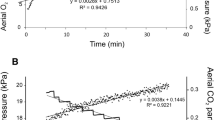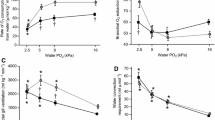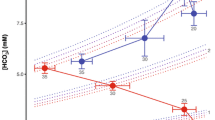Abstract
The evolutionary transition from water-breathing to air-breathing involved not only a change in function of the organs of respiratory gas exchange and N-waste excretion, but also in the organs of ion uptake from the environment. A combination of in vivo and in vitro techniques was used to look at the relative importance of the gills versus the gut in Na+, Cl−, and K+ balance in two closely related erythrinid species: a facultative air-breather, the jeju (Hoplerythrinus unitaeniatus) and an obligate water-breather, the traira (Hoplias malabaricus). The jeju has a well-vascularized physostomous swimbladder, while that in the traira is poorly vascularized, but the gills are much larger. Both species are native to the Amazon and are common in the ion-poor, acidic blackwaters of the Rio Negro. Under fasting conditions, the traira was able to maintain positive net Na+ and Cl− balance in this water, and only slightly negative net K+ balance. However, the jeju was in negative net balance for all three ions and had lower plasma Na+ and Cl− concentrations, despite exhibiting higher branchial Na+,K+ATPase and v-type H+ATPase activities. In the intestine, activities of these same enzymes were also higher in the jeju, and in vitro measurements of net area-specific rates of Na+, Cl−, and K+ absorption, as well as the overall intestinal absorption capacities for these three ions, were far greater than in the traira. When acutely exposed to disturbances in water O2 levels (severe hypoxia ~15 % or hyperoxia ~420 % saturation), gill ionoregulation was greatly perturbed in the traira but less affected in the jeju, which could “escape” the stressor by voluntarily air-breathing. We suggest that a shift of ionoregulatory capacity from the gills to the gut may have occurred in the evolutionary transition to air-breathing in jeju, and in consequence branchial ionoregulation, while less powerful, is also less impacted by variations in water O2 levels.









Similar content being viewed by others
References
Bradford MM (1976) A rapid and sensitive method for the quantitation of microgram quantities of protein utilizing the principle of protein-dye binding. Anal Biochem 72:248–254
Brauner CJ, Matey V, Wilson JM, Bernier NJ, Val AL (2004) Transition in organ function during the evolution of air-breathing; insights from Arapaima gigas, an obligate air-breathing teleost from the Amazon. J Exp Biol 207:1433–1438
Bucking C, Wood CM, Grosell M (2013) Uptake, handling and excretion of Na+ and Cl− from the diet in vivo in freshwater and seawater-acclimated killifish, Fundulus heteroclitus, an agastric teleost. J Exp Biol 216:3925–3936
Cameron JN, Wood CM (1978) Renal function and acid-base regulation in two Amazonian Erythrinid fishes: Hoplias malabaricus, a water-breather, and Hoplerythrinus unitaeniatus, a facultative air-breather. Can J Zool 56:917–930
De Boeck G, Wood CM, Iftikar FI, Matey V, Scott GR, Sloman KA, da Silva MDNP, Almeida-Val VMF, Val AL (2013) Interactions between hypoxia tolerance and food deprivation in Amazonian oscars, Astronotus ocellatus. J Exp Biol 216:4590–4600
Dejours P (1975) Principles of comparative respiratory physiology. North-Holland Publishing Company, Amsterdam
Dejours P (1988) Respiration in Water and Air: In: Adaptations-Regulation-Evolution. Elsevier Science Ltd., Amsterdam
Driedzic WR, Phleger CF, Fields JH, French C (1978) Alterations in energy metabolism associated with the transition from water to air breathing in fish. Can J Zool 56:730–735
Farrell AP, Randall DJ (1978) Air-breathing mechanics in two Amazonian teleosts, Arapaima gigas and Hoplerythrinus unitaeniatus. Can J Zool 56:939–945
Fernandes MN, Rantin FT, Kalinin AL, Moron SE (1994) Comparative study of gill dimensions of three erythrinid species in relation to their respiratory function. Can J Zool 72:160–165
Glass ML, Rantin FT (2009) Gas exchange and control of respiration in air-breathing Teleost fish. In: Glass ML, Wood SC (eds) Cardio-respiratory control in vertebrates—evolutionary and evolutionary aspects. Springer, Heidelberg
Graham JB (1997) Air-breathing fishes: evolution, diversity, and adaptation. Academic Press, San Diego
Grosell M (2011) The role of the gastrointestinal tract in salt and water balance. In: Grosell M, Farrell AP, Brauner CJ (eds) The multifunctional gut of fish. Fish Physiol, vol 30. Academic Press, San Diego, pp 135–164
Grosell M, Jensen FB (1999) NO2 − uptake and HCO3 − excretion in the intestine of the European flounder (Platichthys flesus). J Exp Biol 202:2103–2110
Grosell M, Wood CM, Wilson RW, Bury NR, Hogstrand C, Rankin C, Jensen FB (2005) Active bicarbonate secretion plays a role in chloride and water absorption of the European flounder intestine. Am J Physiol 288:R936–R946
Hulbert WC, Moon TW, Hochachka PW (1978a) The erythrinid gill: correlations of structure, function, and metabolism. Can J Zool 56:814–819
Hulbert WC, Moon TW, Bailey J, Hochachka PW (1978b) The occurrence and possible significance of chloride-like cells in the nephron of Amazon fishes. Can J Zool 56:833–844
Iftikar F, Matey V, Wood CM (2010) The ionoregulatory responses to hypoxia in the freshwater rainbow trout Oncorhynchus mykiss. Physiol Biochem Zool 83:343–355
Johannsson OE, Bergman HL, Wood CM, Laurent P, Kavembe DG, Bianchini A, Maina JN, Chevalier C, Bianchini LF, Papah MB, Ojoo RO (2014) Air breathing in the Lake Magadi tilapia Alcolapia grahami, under normoxic and hyperoxic conditions, and the association with sunlight and ROS. J Fish Biol 84:844–863
Johansen K (1972) Heart and circulation in gill, skin and lung breathing. Respir Physiol 14:193–210
Juca-Chagas R (2004) Air breathing of the neotropical fishes Lepidosiren paradoxa, Hoplerythrinus unitaeniatus and Hoplosternum littorale during aquatic hypoxia. Comp Biochem A 139:49–53
Kramer DL (1978) Ventilation of the respiratory gas bladder in Hoplerythrinus unitaeniatus (Pisces, Characoidei, Erythrinidae). Can J Zool 56:931–938
Kramer DL, Lindsey CC, Moodie GEE, Stevens ED (1978) The fishes and the aquatic environment of the central Amazon basin, with particular reference to respiratory patterns. Can J Zool 56:717–729
Kültz D, Somero GN (1995) Osmotic and thermal effects on in situ ATPase activity in permeabilized gill epithelial cells of the fish Gillichthys mirabilis. J Exp Biol 198:1883–1894
Laurén DJ, McDonald DG (1985) Effects of copper on branchial ionoregulation in the rainbow trout, Salmo gairdneri Richardson. J Comp Physiol B155:635–644
LeBlanc DM, Wood CM, Fudge DS, Wright PA (2010) Fish out of water- gill and skin remodeling promotes osmo- and ionoregulation in the mangrove killifish, Kryptolebias marmoratus. Physiol Biochem Zool 83:942–949
Lenfant C, Johansen K (1972) Gas exchange in gill, skin, and lung breathing. Respir Physiol 14:211–218
Lopes JM, de Lima Boijink C, Florindo CLH, Leite CAC, Kalinin AL, Milsom WK, Rantin FT (2010) Hypoxic cardiorespiratory reflexes in the facultative air-breathing fish jeju (Hoplerythrinus unitaeniatus): role of branchial O2 chemoreceptors. J Comp Physiol B 180:797–811
Lushchak VI, Bagnyukova TV (2006) Effects of different environmental oxygen levels on free radical processes in fish. Comp Biochem Physiol B 144:283–289
McKenzie DJ, Campbell HA, Taylor EW, Micheli M, Rantin FT, Abe AS (2007) The autonomic control and functional significance of the changes in heart rate associated with air breathing in the jeju, Hoplerythrinus unitaeniatus. J Exp Biol 210:4224–4232
Nadella SR, Patel D, Ng A, Wood CM (2014) An in vitro investigation of gastrointestinal Na+ uptake mechanisms in freshwater rainbow trout. J Comp Physiol B 184:1003–1019
Oliveira RD, Lopes JM, Sanches JR, Kalinin AL, Glass ML, Rantin FT (2004) Cardiorespiratory responses of the facultative air-breathing fish jeju, Hoplerythrinus unitaeniatus (Teleostei, Erythrinidae), exposed to graded ambient hypoxia. Comp Biochem Physiol A 139:479–485
Pelster B, Wood CM, Speers-Roesch B, Driedzic WR, Almeida-Val V, Val AL (2015) Gut transport characteristics in herbivorous and carnivorous serrasalmid fish from ion poor Rio Negro water. J Comp Physiol B 185:225–241
Perry SF, Reid SG, Gilmour KM, Boijink CL, Lopes JM, Milsom WK, Rantin FT (2004) A comparison of adrenergic stress responses in three tropical teleosts exposed to acute hypoxia. Am J Physiol 287:R188–R197
Pelster B, Giacomin M, Wood CM, Val AL (submitted). In erythrinid fish air-breathing is connected to an improved ROS defense. J Comp Physiol B
Phleger CF, Saunders BS (1978) Swim-bladder surfactants of Amazon air-breathing fishes. Can J Zool 56:946–952
Rahmatullah M, Boyde TR (1980) Improvements in the determination of urea using diacetyl monoxime: methods with and without deproteinization. Clin Chem Acta 107:3–9
Randall DJ, Baumgarten D, Malyusz M (1972) The relationship between gas and ion transfer across the gills of fishes. Comp Biochem Physiol A 41:629–637
Randall DJ, Farrell AP, Haswell MS (1978) Carbon dioxide excretion in the jeju, Hoplerythrinus unitaeniatus, a facultative air-breathing teleost. Can J Zool 56:970–973
Randall DJ, Burggren WW, Farrell AP, Haswell MS (1981) The evolution of air breathing in vertebrates. Cambridge University Press, Cambridge
Rantin FT, Kalinin A, Glass ML, Fernandes MN (1992) Respiratory responses to hypoxia in relation to mode of life of two erythrinid species (Hoplias malabaricus and Hoplias lacerdae). J Fish Biol 41:805–812
Robertson LM, Val AL, Almeida-Val VF, Wood CM (2015) Ionoregulatory aspects of the osmorespiratory compromise during acute environmental hypoxia in 12 tropical and temperate teleosts. Physiol Biochem Zool 88:357–370
Sayer MD (2005) Adaptations of amphibious fish for surviving life out of water. Fish Fish 6:186–211
Scott GR, Schulte PM, Wood CM (2006) Plasticity of osmoregulatory function in the killifish intestine: drinking rates, salt and water transport, and gene expression after freshwater transfer. J Exp Biol 209:4040–4050
Smith HW (1959) From fish to philosopher. The story of our internal environment. Revised edition. Ciba, Chicago
Smith NF, Talbot C, Eddy FB (1989) Dietary salt intake and its relevance to ionic regulation in freshwater salmonids. J Fish Biol 35:749–753
Stevens ED, Holeton GF (1978) The partitioning of oxygen uptake from air and from water by erythrinids. Can J Zool 56:965–969
Truchot JP (1987) Comparative aspects of extracellular acid-base balance. Springer, Berlin
Ultsch GR (1996) Gas exchange, hypercarbia and acid-base balance, paleoecology, and the evolutionary transition from water-breathing to air-breathing among vertebrates. Palaeogeogr Palaeoclimatol Palaeoecol 123:1–27
Val AL, Almeida-Val VMF(1995) Fishes of the Amazon and their environment. Physiological and biochemical features. Springer, Heidelberg, p 224
Verdouw H, van Echted CJA, Dekkers EMJ (1978) Ammonia determination based on indophenol formation with sodium salicylate. Water Res 12:399–402
Wilkie MP, Morgan TP, Galvez F, Smith RW, Kajimura M, Ip YK, Wood CM (2007) The African lungfish (Protopterus dolloi): osmoregulation and ionoregulation in a fish out of water. Physiol Biochem Zool 80:99–112
Wolf K (1963) Physiological salines for fresh-water teleosts. Prog Fish Cult 25:135–140
Wood CM, Bucking C (2011) The role of feeding in salt and water balance. In: Farrell AP, Brauner CJ (Eds) The multifunctional gut of fish (Fish Physiology, vol 30). Academic Press, San Diego, pp 165–212
Wood CM, Wheatly MG, Hobe H (1984) The mechanisms of acid-base and ionoregulation in the freshwater rainbow trout during environmental hyperoxia and subsequent normoxia III. Branchial exchanges. Respir Physiol 55:175–192
Wood CM, Iftikar FI, Scott GR, De Boeck G, Sloman KA, Matey V, Valdez Domingos FX, Duarte RM, Almeida-Val VMF, Val AL (2009) Regulation of gill transcellular permeability and renal function during acute hypoxia in the Amazonian oscar (Astronotus ocellatus): new angles to the osmo respiratory compromise. J Exp Biol 212:949–964
Zall DM, Fisher D, Garner MQ (1956) Photometric determination of chloride in water. Anal Chem 28:1665–1668
Zheng W, Wang Z, Collins JE, Andrews RM, Stemple D, Gong Z (2011) Comparative transcriptome analyses indicate molecular homology of zebrafish swimbladder and mammalian lung. PLoS One 6:e24019
Acknowledgments
Supported by FAPEAM and CNPq through the INCT-ADAPTA grant to ALV and VMFAV, a Ciência sem Fronteiras Grant to ALV and CMW, and an NSERC Discovery Grant to CMW. CMW is the recipient of a fellowship from the Ciência sem Fronteiras Program (CNPq-Brazil). ALV and VFAV are recipients of research fellowships from CNPq-Brazil. MG is supported by a Four Year Graduate Fellowship from the University of British Columbia. HSH was the recipient of a CNPq post-Doctoral fellowship from the Ciência sem Fronteiras Program. Special thanks to Gudrun De Boeck for the osmolality measurements, to Maria de Nazaré Paula da Silva, Sunita Nadella, and Ora Johannsson for assistance, and to two anonymous reviewers for constructive criticism.
Author information
Authors and Affiliations
Corresponding author
Additional information
Communicated by G. Heldmaier.
C. M. Wood and B. Pelster contributed equally to this paper.
Rights and permissions
About this article
Cite this article
Wood, C.M., Pelster, B., Giacomin, M. et al. The transition from water-breathing to air-breathing is associated with a shift in ion uptake from gills to gut: a study of two closely related erythrinid teleosts, Hoplerythrinus unitaeniatus and Hoplias malabaricus . J Comp Physiol B 186, 431–445 (2016). https://doi.org/10.1007/s00360-016-0965-5
Received:
Revised:
Accepted:
Published:
Issue Date:
DOI: https://doi.org/10.1007/s00360-016-0965-5




